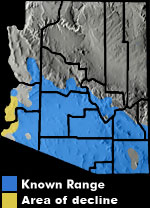Online Field Guide to The Reptiles and Amphibians of Arizona



Santa Cruz County, AZ
 Juvenile. Arizona. |
| SONORAN DESERT TOAD Incilius alvarius | |
|
DESCRIPTION: Arizona’s largest toad, Sonoran Desert toads grow to 7.5 inches or more in length. They resemble frogs in that they have relatively smooth, typically olive-green/brown skin, but they can be identified as toads by the crests on the head (cranial crests), and prominent, elongated glands on both sides of the back of the head (parotoid glands) and on the hind legs. Young toads have small dark, orange-tipped spots on the back. Larger tadpoles are gray or brown with a rounded tail tip, and grow to about 2.25 inches. DISTRIBUTION: This species occurs across southern Arizona, but is absent from the higher mountains and arid, western desert valleys. HABITAT: This toad is found in Sonoran Desertscrub, semi-desert grasslands, oak, and occasionally pine-oak woodlands to about 5,800 feet. It is found the from valley bottoms well into lower-elevation hills and mountains. To the west, the species becomes increasingly tied to permanent water, such as major rivers or the edges of agriculture. Elsewhere it may be found many miles from water, particularly during the summer monsoons. BEHAVIOR: Most Sonoran Desert toads are found at night during the monsoon season, but they may emerge a month or more before the summer rains begin, particularly in areas of permanent water. Outside of the summer activity period, Sonoran Desert toads remain in rodent burrows or other underground retreats. REPRODUCTION AND CALLS: Breeding usually occurs on one night within 2 or 3 days of a rainfall event of greater than one inch. However, at some permanent water localities, breeding may be independent of rainfall. They breed in permanent or temporary waters such as cattle tanks, reservoirs, backwaters, and ponds. Males either call for females from the shallow waters of the breeding pond or actively search for females. The call resembles a ferry boat whistle. Females deposit long stringers of up to 8,000 eggs in shallow water. Tadpoles typically metamorphose in a month or less. DIET: Sonoran Desert toads eat just about anything that moves and will fit into their mouths, including insects, centipedes, spiders, lizards, mice, and other amphibians. REMARKS: The species’ skin toxins are strong enough to kill a dog and reportedly have hallucinogenic qualities. Sometimes called the “Colorado River toad”, the species has declined in western Arizona, where it has been confirmed only once on the Colorado River since 1986. A 2004 observation at a golf course in the Parker Strip indicates it still persists in the Colorado River corridor. There have been unconfirmed, recent reports from lands of the Colorado River Indian Tribes, as well. The species is apparently extirpated from southeastern California and has declined in New Mexico. By Jim Rorabaugh
Degenhardt, W.G., C.W. Painter, and A.H. Price. 1996. Amphibians and Reptiles of New Mexico. University of New Mexico Press, Albuquerque. Fouquette, M.J. 1970. Bufo alvarius. Catalogue of American Amphibians and Reptiles 93:1-93.4. Fouquette, M.J., Jr., C.W. Painter, and P. Nanjappa. 2005. Bufo alvarius Girard, 1859 Colorado River toad. Pages 384-386 in M.J. Lannoo (ed), Amphibian Declines: The Conservation Status of United States Species. University of California Press, Berkeley, CA. Jennings, M.R., and M.P. Hayes. 1994. Amphibian and Reptile Species of Special Concern in California. Inland Fisheries Division, California Department of Fish and Game, Rancho Cordova, CA. |
|
Visit Partners in Amphibian and Reptile Conservation:


HOME
Copyright © 2023, Arizona Game and Fish Department. All rights reserved.
If you make use of the textual contents of this site in reports, publications, etc. please cite and credit the author(s) and photographer(s). All photos on this website are copyrighted. However, those found in the species account section may be used for any noncommercial scientific, educational, or conservation purposes provided that photographs are not altered and continue to bear the copyright symbol and name of the photographer. Please contact the photographer regarding commercial use of copyrighted photographs.











